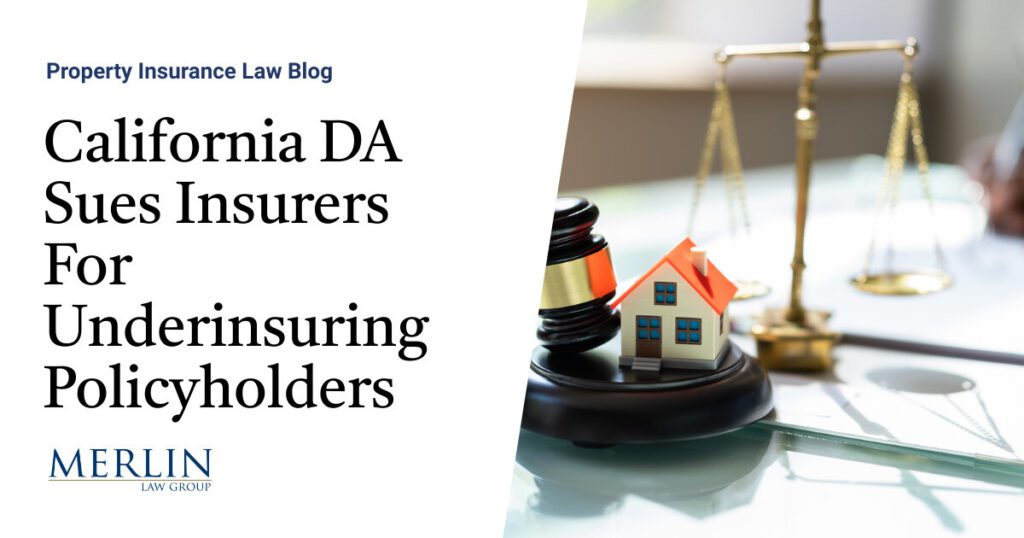California DA Sues Insurers For Underinsuring Policyholders

An Insurance Journal article, D.A. in California Sues Farmers, Other Home Insurers Alleging Scheme to Underinsure, caught my attention. While district and state attorneys are usually tasked with consumer protection, they rarely file lawsuits against insurers because state departments of insurance theoretically regulate those insurers.
A press release from the district attorney’s office noted:
Alameda County District Attorney Pamela Price announces that her Consumer Justice Bureau has sued multiple home insurance carriers comprising 15% of the home insurance market in California, including Farmers Insurance Exchange, alleging they operate a widespread scheme that knowingly and systematically underinsures homes in California. The complaint alleges that these home insurance carriers provide consumers with inaccurately low replacement cost estimates, far less than the amount needed to rebuild their homes in the event of a disaster. This violates insurance regulations requiring any such communication to ‘include the expenses that would reasonably be incurred to rebuild the insured structure(s) in its entirety.’
To generate replacement cost estimates, these home insurance carriers utilize third-party software that considers very little information about the specific home to be insured, instead relying upon generalized features like the home’s zip code. Thus, as alleged in the Complaint, the amount of insurance coverage purchased by homeowners is based on an estimate to rebuild a hypothetical home, not the actual home for which consumers are purchasing coverage. By avoiding the costs required to obtain detailed information about a home’s actual features and characteristics, home insurance providers offer lower premiums to increase their competitive position in the marketplace. However, this scheme also leads to systemic underinsurance in California, leaving homeowners without the means to replace what are often their most valuable assets.
The Complaint alleges that despite home insurance companies’ duty to deal in good faith with consumers, the home underinsurance scheme violates numerous California laws, including Insurance Code regulations and California’s Unfair Competition and False Advertising Laws. The lawsuit seeks civil penalties and injunctive relief prohibiting home insurance carriers from continuing their conduct harming homeowners across California.
‘The relationship between an insurer and the homeowner is necessarily one of unequal knowledge, expertise, information, and bargaining power, with homeowners depending on the insurance company to act in good faith,’ said District Attorney Pamela Price. ‘When an insurance company provides a homeowner with a replacement cost estimate, that estimate must pertain to the homeowner’s actual home, not some hypothetical home that suits the insurance company’s bottom line. Insurance companies must disclose all facts known only to them that are material to a homeowner’s policy, and they owe prospective clients 65 or older an additional duty of honesty, good faith, and fair dealing. This lawsuit will ensure that homeowners receive the information they are entitled to receive before purchasing coverage so that they can adequately protect what are often their most valuable assets,’ said District Attorney Pamela Price.
Some may wonder why insurance companies would ever intentionally underinsure risks. I found one comment written by an insurance agent to the Insurance Journal article revealing:
Having met with the DOI multiple times in the past 17 years, I have handed them 5 or 6 replacements cost estimates each time from different carriers for my own home. As licensed Agent and Contractor myself, I have explained to them that there should not be a variance of more than 10% from the lowest to highest (each time I had received anywhere from 20-50% variances from the MSB with my carrier that I would say was the most accurate. The reason the carriers are doing that is to either be competitive or uncompetitive in a given region. That is due to a poorly written 103 that forces carriers to justify rates. Therefore, they are able to increase or decrease rates using the COV A limit within their rate structure. The CSLB could actually work with DOI in developing a tool that could not be manipulated rather than allowing carriers to put consumers at risk.
The problem of underinsurance is significant. The insurance industry does not seem to be taking corrective measures to stop this problem. United Policyholders has made this issue a priority, repeatedly noting how it is a plague that routinely occurs whenever a total loss happens. It is not just a problem in California, as noted in Colorado Insurance Commissioner Talks About the Underinsurance Problems in Colorado.
Whether this complaint by the district attorney results in anything substantial is yet to be determined. The insurers are denying any liability. Still, there is a substantial underinsurance problem in the property insurance market, and there is no indication of it stopping.
Thought For The Day
He who cures a disease may be the skillfullest, but he that prevents it is the safest physician.
—Thomas Fuller



